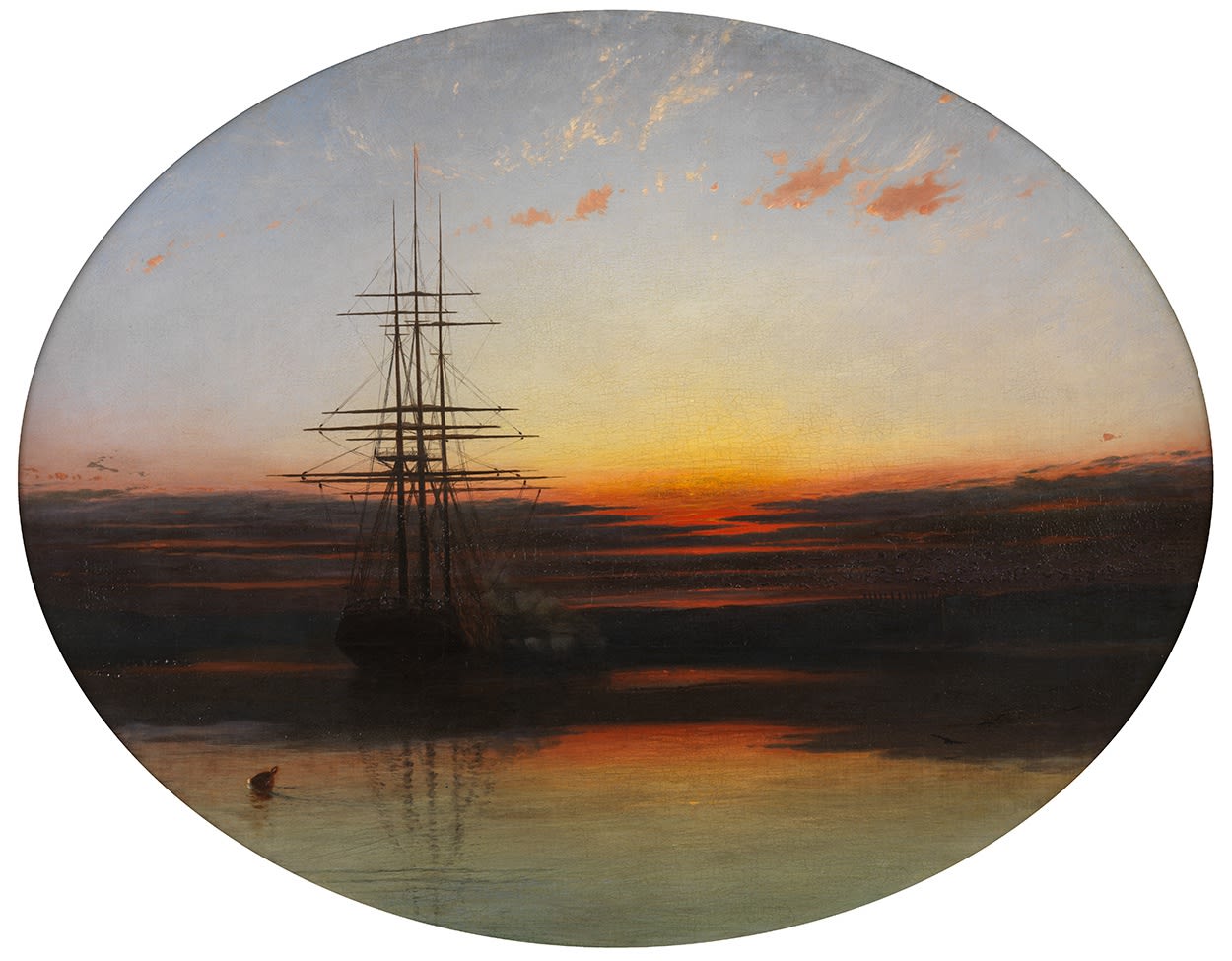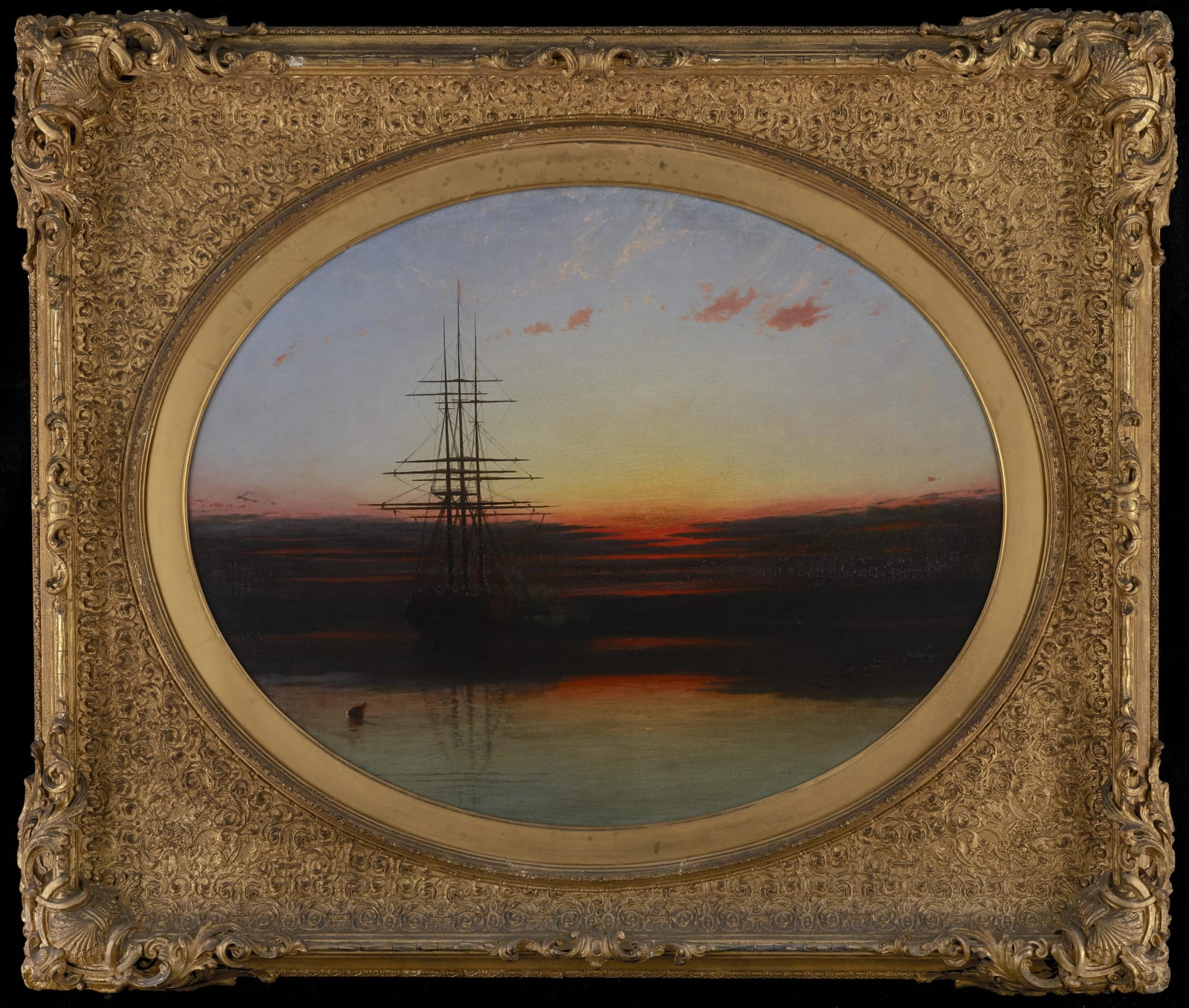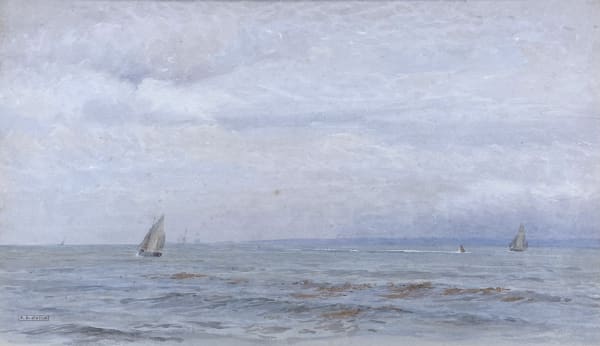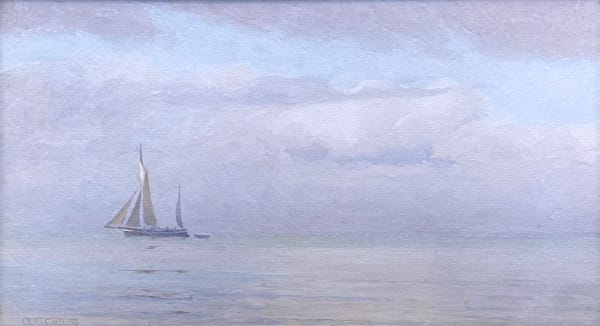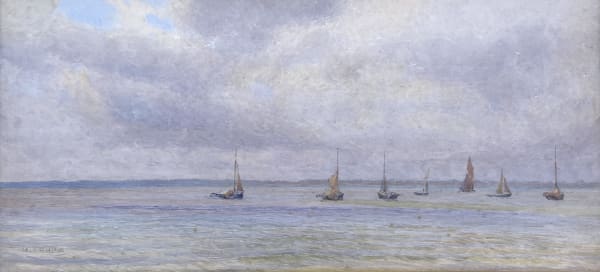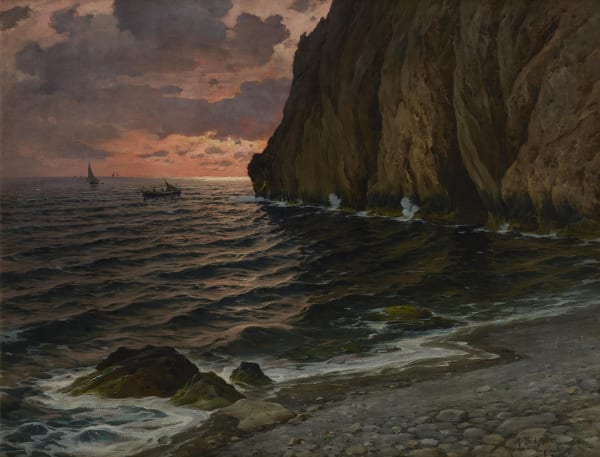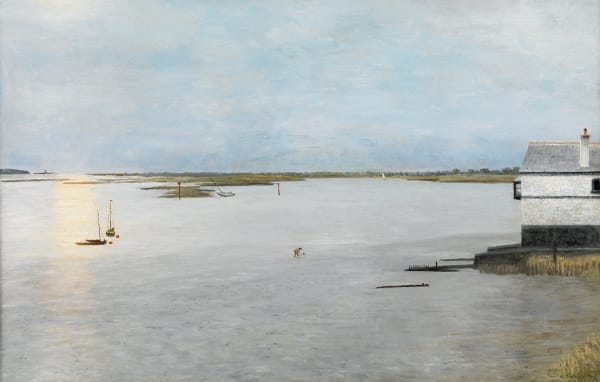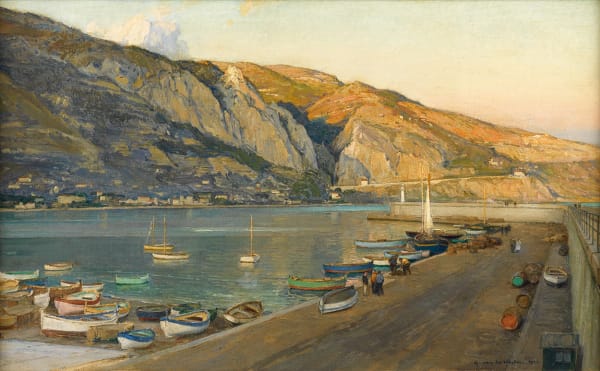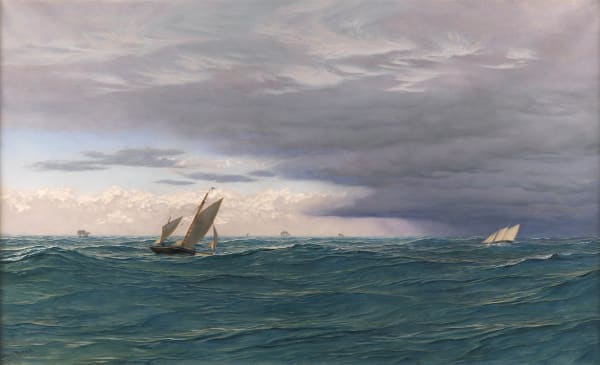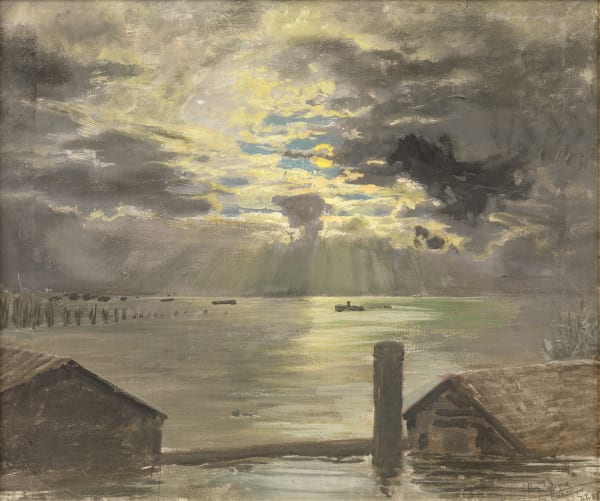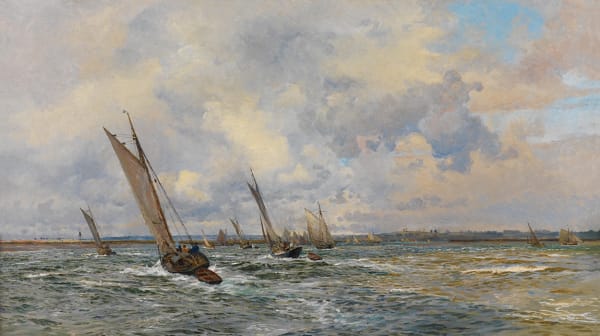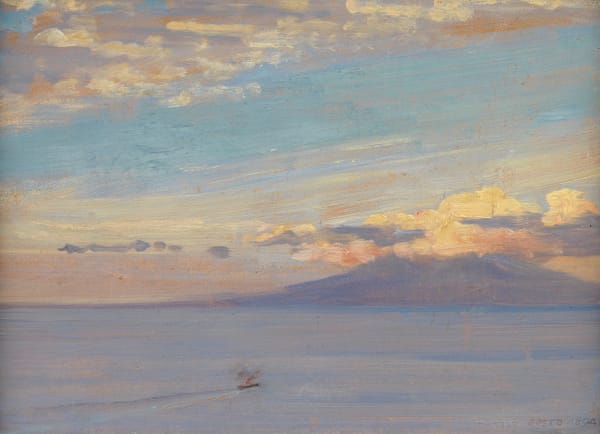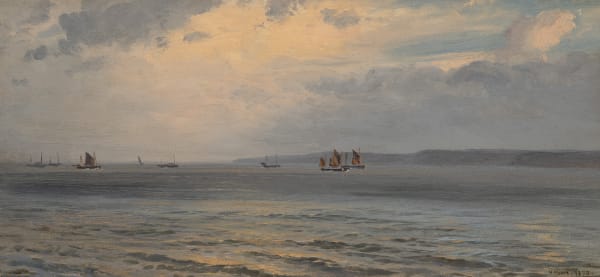Francis Danby (1793-1861)
Provenance
Purchased from the artist by Thomas Pemberton of Heathfield hall, Handsworth;
his sale, Christie’s 30 April 1874 (29), bought J. Watson of Warley Hall, Birmingham;
thence by descent
Literature
Eric Adams, Francis Danby: Varieties of Poetic Landscape, New Haven, 1973, mentioned under no 193, p 183, 197
At the Royal Academy in 1848, Francis Danby exhibited his first version of The Evening Gun (now lost). It ‘was the picture,’ said David Roberts, ‘all the painters were talking about it’. It was still more extravagantly praised when it was shown at the Paris International Exhibition in 1855. Théophile Gautier wrote: ‘It is impossible to describe the poetic effect of this scene: there is a calmness, a silence, a solitude which deeply affects the soul. Never has the solemn grandeur of the ocean been better expressed.’ It became the principal work upon which Danby’s reputation rested. Two further versions followed. All the versions differ, and in this fourth and last (painted for his friend the collector Thomas Pemberton, a brass founder), the clouds are denser and the contrasts of tone much stronger. It is moments later than in the other versions, when darkness has advanced, and light is limited to the sky and its reflection in the water. Forms, such as the distant hills or the hulk to the right, are revealed only by the light beyond. Danby observed these effects afresh. The masts, spars and rigging differ substantially in the other versions, but here their special precision and elegance dominate the painting.
Danby delighted in ‘deep toned pictures’, as he called them, although he found them hard to sell. He could not give them up, and wrote to a friend: ‘you know in this I am incurable.’ Danby’s fascination for the effects of the last moments of sunlight and of twilight, moonlight and dawn was not to be denied by market forces. To achieve these rich and sombre tones, this picture has been painted on a bituminous ground in some parts, which has separated, although it is now stable.
-
 Edward Frederick Brewtnall (1846-1902)The Cloud's Turmoil, the Sun's Fierce Molten Fire
Edward Frederick Brewtnall (1846-1902)The Cloud's Turmoil, the Sun's Fierce Molten Fire -
 John Samuel Raven (1829-1877)Sheep in a Storm
John Samuel Raven (1829-1877)Sheep in a Storm -
 Alma Claude Burlton Cull (1880-1931)A Grey Day in the Solent£1,800
Alma Claude Burlton Cull (1880-1931)A Grey Day in the Solent£1,800 -
 Alma Claude Burlton Cull (1880-1931)A Still Morning£1,800
Alma Claude Burlton Cull (1880-1931)A Still Morning£1,800 -
 Alma Claude Burlton Cull (1880-1931)Sailing Boats at Anchor£1,800
Alma Claude Burlton Cull (1880-1931)Sailing Boats at Anchor£1,800 -
 Michele Federico (1884-1966)CapriPOA
Michele Federico (1884-1966)CapriPOA -
 John Brett (1831-1902)Sunset off Lundy IslandPOA
John Brett (1831-1902)Sunset off Lundy IslandPOA -
 Sidney Richard Percy (1821-1886)Grange-over-Sands, and, Lancaster Sands£6,000
Sidney Richard Percy (1821-1886)Grange-over-Sands, and, Lancaster Sands£6,000 -
 Henry Moore (1831-1895)Sunset on the Coast£4,800
Henry Moore (1831-1895)Sunset on the Coast£4,800 -
 Richard Eurich (1903-1992)Low Tide, Beaulieu River£6,800
Richard Eurich (1903-1992)Low Tide, Beaulieu River£6,800 -
 Harry van der Weyden (1868-1952)The Harbour at Menton, Côte d'Azur£6,000
Harry van der Weyden (1868-1952)The Harbour at Menton, Côte d'Azur£6,000 -
 William Pye (1855-1934)A Rough Day at Leigh£2,800
William Pye (1855-1934)A Rough Day at Leigh£2,800 -
 William Lionel Wyllie (1851-1931)The Sea-Beach after a Storm - Time, DawnPOA
William Lionel Wyllie (1851-1931)The Sea-Beach after a Storm - Time, DawnPOA -
 John Brett (1831-1902)Yachts in a Seaway, MediterraneanPOA
John Brett (1831-1902)Yachts in a Seaway, MediterraneanPOA -
 Richard Eurich (1903-1992)Shipping in the Solent£6,200
Richard Eurich (1903-1992)Shipping in the Solent£6,200 -
 Sir Lawrence Alma-Tadema (1836-1912)Inundation of the RhinePOA
Sir Lawrence Alma-Tadema (1836-1912)Inundation of the RhinePOA -
 James Whitelaw Hamilton (1860-1932)Evening on the ClydePOA
James Whitelaw Hamilton (1860-1932)Evening on the ClydePOA -
 William Lionel Wyllie (1851-1931)Shrimpers Hauling to WindwardPOA
William Lionel Wyllie (1851-1931)Shrimpers Hauling to WindwardPOA -
 John Brett (1831-1902)Newquay, CornwallPOA
John Brett (1831-1902)Newquay, CornwallPOA -
 Harold Speed (1872-1957)Vesuvius from Capri£6,500
Harold Speed (1872-1957)Vesuvius from Capri£6,500 -
 Henry Moore (1831-1895)SeascapePOA
Henry Moore (1831-1895)SeascapePOA -
 Alexander Stanhope Forbes (1857-1947)A Sketch, Mousehole Harbour, CornwallPOA
Alexander Stanhope Forbes (1857-1947)A Sketch, Mousehole Harbour, CornwallPOA
The Maas Gallery, 6 Duke Street, St. James's, London, SW1Y 6BN
+44 (0) 20 7930 9511 | mail@maasgallery.com
This website uses cookies
This site uses cookies to help make it more useful to you. Please contact us to find out more about our Cookie Policy.
